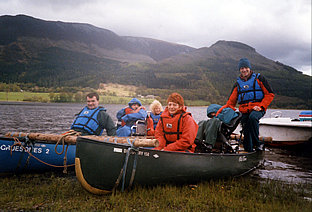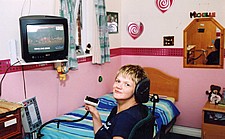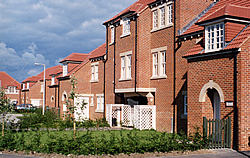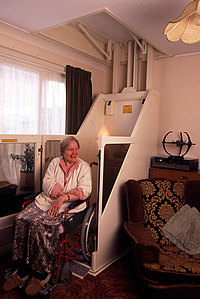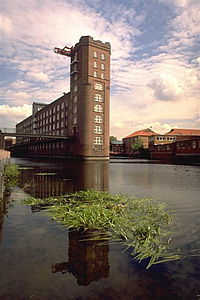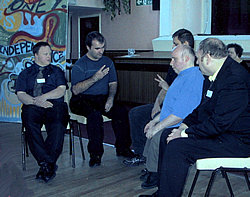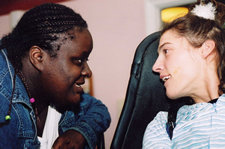In 1961, the Foundation begins twenty years of support for the National Institute for Social Work Training to improve social work practice. By 1993, nearly a quarter of JRF research funding goes on examining the barriers disabled people face and how these might be overcome.
In 1995, the Disability Discrimination Act brings disabled people rights relating to work, services and property. And in 2000 the Government establishes the Disability Rights Commission - working towards eliminating discrimination against disabled people.
If we are disabled, how do we live independently? How is our family life affected? And how can we choose and control the support we need?
Independent living
By the 1970s disabled people are challenging perceptions of themselves as needing charity, treatment or change in order to fit into society. The ‘social model’ of disability highlights how social attitudes and the environment exclude disabled people. This goes much further than physical access to buildings. Poverty, opportunities in work and education – as well as the denial of choice and civil rights – may all hinder disabled people as they seek to lead independent lives. This does not mean ‘doing everything for yourself’. Disabled people have defined ‘independent living’ as having choice and control over all aspects of life – from housing to work, from relationships to support services.
In 1989, government guidance on implementing community care states that housing “is often the key to independent living”. There is a general move away from the concept of segregated ‘special needs’ housing. But, right from the start, many local authority housing departments express concern about the extent of their involvement in joint planning for community care. For people who become disabled, equipment and adaptations in their existing home can make a huge difference: £220 million is being spent on adaptations every year by 2001 – although not all are as effective as they might be. Initiatives like Lifetime homes aim to make everyone’s home more accessible generally – and easier to adapt when necessary. In 1992 the Joseph Rowntree Housing Trust starts work on the Woodlands estate in York, the first to be built entirely to ‘Lifetime homes’ standards.
By 2000, research from the LSE finds disabled people make up between 12 and 16 per cent of the working-age population. But half of all disabled people have incomes below half the general population average. Two in five are in poverty – an increase of one-sixth since 1985. In 2003, research reveals that those on low incomes are more likely to become disabled in the first place.
Employment rates among disabled people are low, at around 40 per cent. But disabled people find their own ways of managing work. And supported employment provides opportunities for people with learning difficulties.
Family life
From the start, parents of disabled children can be at a disadvantage. In 1998, research finds they face three times the costs of parents of non-disabled children. Again getting suitable housing can be a major problem.
Between 1973 and 1996, the Foundation’s administration of The Family Fund provides insight into the additional needs of severely disabled children. The Children Act 1989 brings children new rights to be consulted on what services they need. Young disabled people find new ways of getting a voice.
Families where one or both parents is a disabled person can experience social exclusion and negative attitudes. Disabled parents find it hard to access ‘mainstream’ services – often falling between services for disabled adults and those for children. For some, lack of support services means they have to rely on their children – so their children become ‘young carers’. Often disabled parents find they are considered to be in need of ‘care’ rather than requiring assistance with parenting. There may even be an assumption that their children would be better off being taken into the care of the local authority.
Becoming a parent is not the only milestone which young disabled people find difficult as they move into adulthood. Access to housing, education, benefits and employment services – even just having a laugh with friends – can all be much more complex than for their non-disabled peers. And certain groups of disabled people – particularly those from minority ethnic communities and those with mental health issues – can face ‘double discrimination’.
New issues emerge as we get older. In the early 1900s, the average person lives to around 48. One hundred years later, average life expectancy is around 78 – and likely to increase further. But the term ‘older people’ covers a very diverse group; a programme of work concluding in 2004 gathers their own views of the issues.
How can we choose and control services?
The Foundation’s interest in social services begins in 1961 with its support for the National Institute for Social Work Training. A number of studies in the 1970s investigate the effective provision of care. Nationally, the 1990s sees a shift from the providers’ perspective to getting users themselves involved in managing and running services. Legislation on direct payments allows disabled people to purchase and manage their own support. New ways are found of enabling disabled people to evaluate and plan services.
Work with people with learning difficulties looks at ways of helping them get more involved in running services. In 1997 the Foundation initiates publication of the first Plain Facts, award-winning research summaries designed to keep people with learning difficulties informed and better able to influence both practice and policy.
New work continues to examine the main barriers to achieving better personal support. A programme on Independent Living, starting in 2004, will explore approaches to achieving choice and control for disabled people, older people and other groups – looking for solutions that have credibility with service users.
Find out more about the Foundation’s care services, current research priorities and how it is working to effect change.

